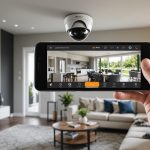Overview of Smart Home Command Centers
A smart home command center acts as the central hub for managing smart devices, making daily life more efficient and streamlined. It orchestrates various systems like lighting, heating, and security, allowing homeowners to control everything from a single interface. With the rise of smartphone integration, managing a smart home has become even more accessible. Smartphones play a pivotal role in this ecosystem, functioning like a remote control for your home. They enable users to monitor and adjust devices no matter where they are, ensuring they can optimize comfort and security at all times.
Popular smart home ecosystems provide comprehensive solutions. For example, platforms like Apple HomeKit, Google Home, and Amazon Alexa create a network of compatible devices that communicate seamlessly with one another. These ecosystems often integrate with third-party applications and gadgets, expanding the possibilities for a connected lifestyle. They offer an intuitive user experience, leveraging voice commands and app control for easier management of smart home operations. Consequently, users can enjoy the convenience and innovation that smart home command centers bring, all while keeping their environment secure and tailored to their preferences.
Also to read : Master Home Automation: A Comprehensive Guide to Managing Your Smart Home via Smartphone
Overview of Smart Home Command Centers
Smart home command centers are centralized platforms designed to manage and control various smart devices within a household. They provide users with a streamlined way to operate and automate their homes, transforming everyday living into a more convenient and efficient experience. These command centers often integrate seamlessly with smartphones, allowing users to control devices remotely through dedicated apps.
A smart home command center serves as the nucleus of a connected home, interfacing with numerous devices such as lights, thermostats, security systems, and more. Through smartphone integration, users can easily adjust settings, monitor energy consumption, and receive alerts, enhancing their overall experience. The ability to manage your home from the palm of your hand provides a sense of reliability and control.
Have you seen this : Mastering Smart Home Surveillance: Step-by-Step Smartphone Installation Guide
Popular smart home ecosystems include systems like Apple’s HomeKit, Google’s Nest, and Amazon’s Alexa, each offering unique benefits and features. These ecosystems are designed to work well with a wide range of smart devices, encouraging a cohesive and harmonious setup. As these ecosystems continue to evolve, they are making smart home management increasingly intuitive and accessible for users of all tech levels. By understanding the full capabilities of your command center, you can optimize its role in your daily life, ensuring your smart home setup functions smoothly and efficiently.
Essential Apps for Smart Home Management
When diving into smart home management, selecting the right smart home apps is crucial for efficient device management. These applications bridge various devices, offering centralized control right at your fingertips. The best apps provide smooth app integration, ensuring all smart devices communicate seamlessly.
Top Apps for Controlling Smart Home Devices
Choosing top-tier apps like Google Home, Apple HomeKit, or Amazon Alexa app can transform how you manage your smart home. Each app offers unique features, catering to different user needs and device ecosystems.
User Interface and Features
An intuitive user interface is key in smart home apps. Look for features such as voice command compatibility, scheduling options, and custom automation settings. These features simplify managing multiple devices and enhance the overall user experience.
How Apps Integrate with Various Technologies
Successful app integration ensures that your devices are compatible and function optimally. Check for compatibility with popular ecosystems and protocols, such as Zigbee or Z-Wave, to guarantee smooth operation. With the right selection, you can manage everything from lighting to security systems effortlessly, making your smart home truly interconnected.
Using the right apps lays the groundwork for an efficient, responsive, and enjoyable smart home setup.
Customizing Your Smart Home Experience
To truly embrace a smart home setup, personalization is key. Users can tailor devices to fit specific needs, creating a bespoke living environment. By adjusting settings for lighting, climate, and security, homeowners can craft an atmosphere that complements their lifestyle. This customization allows homes to respond intuitively to daily routines and preferences, enhancing overall comfort and efficiency.
Setting up routines and automations elevates convenience to a new level. Imagine walking into a room that automatically adjusts the brightness based on the time of day or a thermostat that adapts to your schedule. Automations ensure that your home environment is always just right, without needing manual adjustments.
Voice assistants play a pivotal role in this personalized setup. They offer hands-free control, enabling users to operate multiple devices through simple voice commands. This functionality not only simplifies interactions but also fosters a more intuitive experience.
Ultimately, customization transforms smart homes from mere collections of devices into cohesive, responsive systems. By embracing these options, users can significantly enhance their living experience, making daily tasks more manageable and enjoyable. Customization is not just about adding smart features; it’s about integrating them seamlessly into everyday life to maximize their potential.
Device Compatibility and Integration
For a successful smart home setup, ensuring device compatibility is crucial. Check for compatibility with popular ecosystems like Apple HomeKit, Google Home, or Amazon Alexa. This guarantees that your smart devices can communicate effectively. Look for devices supporting universal protocols such as Bluetooth, Zigbee, or Z-Wave, which enhance integration and simplify management.
Key Factors for Device Compatibility
- Ecosystem Alignment: Choose devices within the same ecosystem for simpler setup and comprehensive support.
- Protocol Support: Ensure your devices support common protocols, aiding seamless communication.
- Firmware Updates: Regular updates maintain compatibility and improve device functions.
Ensuring Seamless Integration
To achieve seamless integration, verify Wi-Fi and network configurations. Stability and speed are paramount. Consider mesh networks to cover large areas and minimize dead spots. Consistent connectivity ensures devices operate smoothly, reducing lag or disconnections.
Importance of Wi-Fi and Network Configurations
A stable Wi-Fi framework is essential for the functionality of smart home devices. Position your router centrally for optimal coverage. Use higher frequency bands, like 5 GHz, to support devices demanding more bandwidth. Correct network configurations not only streamline the integration process but also amplify the smart home’s performance and reliability.
Overcoming Challenges in Smart Home Management
Smart home management poses unique challenges that can impede the smooth functioning of devices. Addressing connectivity issues is crucial, as they often disrupt device performance. A common solution involves ensuring robust Wi-Fi coverage across your home. Placing your router centrally can enhance signal strength, making smart devices more reliable.
Troubleshooting app and device conflicts is another frequent concern. Conflicts usually arise from compatibility issues between different devices and apps. To resolve this, always update apps and firmware to the latest versions, which can iron out bugs and improve integration strategies. Reading user guides and utilizing customer support for specific concerns may prove beneficial.
Boosting performance and reliability is pivotal amidst smart home challenges. Regularly checking network configurations for optimal speed and reliability ensures that smart systems function smoothly. It’s also wise to prioritize critical devices in your network settings, ensuring high-priority gadgets receive ample bandwidth.
For enhanced performance and reliability, conducting periodic system audits helps identify weak spots in your setup. By evaluating device performance and connection strength, addressing these challenges becomes achievable, allowing a more seamless and enjoyable smart home experience.
Overcoming Challenges in Smart Home Management
In the journey towards achieving a functional smart home, users often encounter common connectivity issues. The fundamental problem usually lies in Wi-Fi coverage or network settings. Ensuring a stable connection is crucial. Employing mesh networks or signal boosters can mitigate dead zones and improve device responsiveness. Understanding these underlying issues allows for more precise troubleshooting.
When app and device conflicts arise, they can impede seamless operation. Start by examining app permissions and device firmware versions. Ensuring they’re up to date is imperative, as updates typically resolve compatibility issues and enhance performance. Checking the manufacturer’s website for troubleshooting guides can also prove beneficial.
Performance and reliability challenges can often be resolved by prioritizing specific devices on your network. Utilising Quality of Service (QoS) settings can allocate bandwidth efficiently, ensuring critical devices remain functional during peak usage times.
For troubleshooting further, monitoring network traffic and identifying heavy usage patterns can help identify bottlenecks. This insight aids in configuring optimal settings, thereby enhancing overall smart home reliability. Employing these troubleshooting solutions fosters a more enjoyable and uninterrupted smart home experience, ensuring users maintain the technological convenience they’re invested in.
Expert Tips for Maximizing Smart Home Efficiency
Maximizing smart home efficiency involves adopting strategic optimization strategies to enhance performance. Begin by managing energy consumption effectively. Employ smart thermostats and energy-efficient bulbs to monitor and reduce energy use without compromising comfort. These devices allow scheduling to maximize savings, adapting to your habits and needs.
Maintaining security is crucial in a smart home. Regular firmware updates and robust passwords fortify your setup against cyber threats. Implement multi-factor authentication where possible for additional security layers. These measures ensure that your devices and personal information remain secure.
Consider upgrades to keep your smart home advanced. Adopting the latest technologies can significantly boost functionality and user experience. For instance, investing in future-proof devices that support emerging protocols like Thread ensures long-term compatibility and efficiency.
To further optimize, examine network infrastructure. A mesh network can increase coverage and reliability, minimizing disruptions in device communication. Ensuring a fast and stable connection allows your smart home system to perform at its best.
Utilize these expert tips to transform your smart home into a model of efficiency, balancing cost, and performance for a smoothly functioning environment. Implementing these approaches not only enhances efficiency but also contributes to a secure, energy-saving, and cutting-edge home setup.
FAQs About Smart Home Command Centers
Addressing frequently asked questions about smart home command centers can help users understand device operations and optimize their setup. One common query is, “How can I ensure my smart home devices function smoothly?” The key is maintaining device compatibility by using a unified ecosystem like Apple HomeKit or Google Home, and investing in compatible devices readily integrating with each other.
Newcomers often ask, “What are essential steps for a smart home beginner?” Start by choosing smart home apps that offer straightforward interfaces and reliable app integration. Opt for apps that accommodate a range of devices, providing a holistic view of your smart home system.
For those curious about enhancing their setup, “What resources are available for learning?” Various online platforms and communities offer detailed guides and user support. Dive into online forums or video tutorials for insights into troubleshooting and customization, which help tackle smart home challenges efficiently.
While smart homes offer convenience, maintaining security is pivotal. Regularly update device software and use strong, unique passwords to protect your system. Such precautions, along with optimization strategies, will ensure your smart home remains secure and efficient.
Expert Tips for Maximizing Smart Home Efficiency
Maximizing smart home efficiency requires implementing strategic optimization strategies. To start, manage energy consumption by using energy-efficient devices like smart thermostats and LED bulbs, which not only cut down on energy use but also lower bills. These devices can adapt to your behavioural patterns, offering both comfort and cost savings.
Security cannot be overlooked in a smart home environment. Regular firmware updates are essential for protecting your system against potential cyber threats. Ensure your network remains secure with strong, unique passwords and, where possible, employ multi-factor authentication for an added layer of protection. These security practices safeguard both your devices and your personal information.
Investing in future-proof technology is another key tip. Consider upgrades that align with the latest advancements, such as devices supporting emerging protocols like Thread. These choices ensure long-term compatibility and provide a seamless user experience as technology evolves.
Finally, improving the network infrastructure is crucial. A solid, fast connection is the backbone of any efficient smart home setup. Implementing a mesh network can increase coverage and minimise dead zones, ensuring reliable device communication. This step helps your smart home system function at its best, delivering optimal performance and reliability.
FAQs About Smart Home Command Centers
Addressing frequently asked questions helps users navigate smart home command centers effectively. Users often wonder, “How can I ensure seamless operation and device connectivity?” Maintaining device compatibility is crucial. Joining a unified ecosystem, such as Apple HomeKit or Google Home, makes integration straightforward, ensuring devices communicate effortlessly.
Newcomers are curious, “What’s the first step in setting up a smart home?” Choosing user-friendly smart home apps is a vital first step. Opt for apps with easy app integration, enabling centralized management of diverse devices through a cohesive interface.
For those keen on exploring further, “What resources are available for deepening knowledge?” A wealth of online platforms offer educational guides and community support. Online forums and tutorials provide insights on smart home challenges, offering practical solutions and tips for personalization and troubleshooting.
Security concerns often arise: “How do I protect my smart home system?” Regularly updating software and applying strong, unique passwords are essential security practices. Implementing these precautions alongside comprehensive optimization strategies enhances both device security and system performance.
By addressing these queries, users can effectively manage their smart home systems, ensuring a reliable, secure, and enjoyable experience tailored to their needs.











